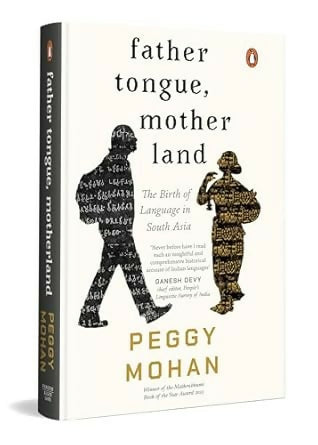FATHER TONGUE, MOTHERLAND: THE BIRTH OF LANGUAGES IN SOUTH ASIA
Regular price
₹ 679
Sale price
₹ 679
Regular price
₹ 699
Unit price
Save 2%
| Item Weight | 380 gram |
| ISBN | 978-0670099740 |
| Author | Ms Peggy Mohan |
| Language | English |
| Publisher | Penguin india |
| Pages | 360 pages |
| Dimensions | 22.2 x 13.9 x 2.31 cm |
| Publishing year | 2025 |

FATHER TONGUE, MOTHERLAND: THE BIRTH OF LANGUAGES IN SOUTH ASIA
Regular price
₹ 679
Sale price
₹ 679
Regular price
₹ 699
Unit price
2% off
Product description
Shipping & Return
Offers & Coupons
How do languages mix? Does it begin in chaos, new migrants and old inhabitants needing a pidgin to communicate? Or does it happen more smoothly, in stages? And what is a prakrit? Why do we hear only of prakrits, and never of pidgins, in South Asia?
In Father Tongue, Motherland, Peggy Mohan looks at exactly how the mixed languages in South Asia came to life. Like a flame moving from wick to wick in early encounters between male settlers and locals skilled at learning languages, the language would start to ‘go native’ as it spread. This produced ‘father tongues’, with words taken from the migrant men’s language, but grammars that preserved the earlier languages of the ‘motherland’.
Looking first at Dakkhini, spoken in the Deccan where north meets south, Mohan goes on to build an X-ray image of a vanished language of the Indus Valley Civilization from the ‘ancient bones’ visible in the modern languages of the area. In the east, she explores another migration of men 4000 years ago that left its mark on language beyond the Ganga-Yamuna confluence. How did the Dravidian people and their languages end up in south India? And what about Nepal, where men coming into the Kathmandu Valley 500 years ago created a hybrid eerily similar to what we find in the rest of the subcontinent?
One image running through this book is of something that remains even when the living form of language fades. Tucked away in how we think and speak now are echoes of our history, and the story of ancestors who lived hundreds and thousands of years ago.
In Father Tongue, Motherland, Peggy Mohan looks at exactly how the mixed languages in South Asia came to life. Like a flame moving from wick to wick in early encounters between male settlers and locals skilled at learning languages, the language would start to ‘go native’ as it spread. This produced ‘father tongues’, with words taken from the migrant men’s language, but grammars that preserved the earlier languages of the ‘motherland’.
Looking first at Dakkhini, spoken in the Deccan where north meets south, Mohan goes on to build an X-ray image of a vanished language of the Indus Valley Civilization from the ‘ancient bones’ visible in the modern languages of the area. In the east, she explores another migration of men 4000 years ago that left its mark on language beyond the Ganga-Yamuna confluence. How did the Dravidian people and their languages end up in south India? And what about Nepal, where men coming into the Kathmandu Valley 500 years ago created a hybrid eerily similar to what we find in the rest of the subcontinent?
One image running through this book is of something that remains even when the living form of language fades. Tucked away in how we think and speak now are echoes of our history, and the story of ancestors who lived hundreds and thousands of years ago.
- Sabr– Your order is usually dispatched within 24 hours of placing the order.
- Raftaar– We offer express delivery, typically arriving in 2-5 days. Please keep your phone reachable.
- Sukoon– Easy returns and replacements within 5 days.
- Dastoor– COD and shipping charges may apply to certain items.
Use code FIRSTORDER to get 5% off your first order.
You can also Earn up to 10% Cashback with POP Coins and redeem it in your future orders.








